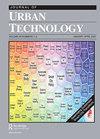互联网+、产业转型与中国城市体系演变
IF 4.4
3区 经济学
Q1 URBAN STUDIES
引用次数: 0
摘要
摘要随着先进的信息通信技术的出现,中国城市的发展态势正在发生重大变化。本研究考察了中国“互联网+”背景下新技术影响下的新兴产业空间格局。从演化经济地理学视角构建理论框架,突出“互联网+”经济与城市体系的相互依存关系。分析发现,城市“互联网+”的发展加剧了新经济资源的空间集聚,导致了少数大城市主导的产业转型和城市体系内部的空间极化。然而,互联网技术的进步也为小城市提供了机会之窗,地方工业基地和相关专业在这一过程中发挥着至关重要的作用。本研究得到国家社会科学基金(19AZD007)和上海市教委创新计划的支持。披露声明作者未报告潜在的利益冲突。注1根据《国家新型城镇化规划(2014 - 2020年)》,中国有17座人口超过500万的特大城市。但一个城市要被列为国家中心城市,不仅要有大量的人口,而且要成为区域发展的引擎。该计划在2010年确定了第一批国家中心城市:北京、天津、上海、重庆和广州。2016年和2018年,成都、武汉、郑州和西安也被列入名单。作者简介:王明峰,华东师范大学人文地理学教授。刘婷婷,乌得勒支大学博士生。她的研究重点是数字创新和区域发展。周伟,武汉规划设计院规划师。她的研究重点是互联网技术和城市发展。本文章由计算机程序翻译,如有差异,请以英文原文为准。
Internet Plus, Industrial Transformation, and China’s Evolving Urban System
ABSTRACTWith the emergence of new and advanced information and telecommunication technologies, Chinese cities are encountering significant changes in their development dynamics. This study examines the spatial pattern of emerging industries under the influence of new technologies within the context of China’s “Internet Plus” initiative. It constructs a theoretical framework from an evolutionary economic geography (EEG) perspective and highlights the interdependence between the Internet Plus economy and urban systems. The analysis finds that the development of Internet Plus in cities intensifies the spatial agglomeration of new economic resources, and results in industrial transformation led by only a few large cities and spatial polarization within the urban system. However, advances in Internet technologies also provide a window of opportunity for smaller cities, and local industrial bases and relevant specializations play a crucial role in this process.KEYWORDS: Internet Pluspath-dependencewindow of opportunityindustrial transformationurban system AcknowledgmentsThe research was supported by National Social Science Foundation of China (19AZD007) and Innovation Program of Shanghai Municipal Education Commission.Disclosure statementNo potential conflict of interest was reported by the author(s).Notes1 According to the National New Urbanization Plan (2014–20), China has 17 megacities whose population is more than 5 million. But to be listed as a national central city, a city should not only have a large population, but also be the engine of regional development. The plan identified the first batch of national central cities in 2010: Beijing, Tianjin, Shanghai, Chongqing, and Guangzhou. In 2016 and 2018, Chengdu, Wuhan, Zhengzhou, and Xi’an were added to the list.Additional informationNotes on contributorsMingfeng WangMingfeng Wang is a professor of human geography at East China Normal University.Tingting LiuTingting Liu is a PhD student at Utrecht University. Her research focuses on digital innovation and regional development.Wei ZhouWei Zhou is a planner at Wuhan Planning and Design Institute. Her research focuses on Internet technology and urban development.
求助全文
通过发布文献求助,成功后即可免费获取论文全文。
去求助
来源期刊

Journal of Urban Technology
URBAN STUDIES-
CiteScore
8.50
自引率
4.20%
发文量
42
期刊介绍:
The Journal of Urban Technology publishes articles that review and analyze developments in urban technologies as well as articles that study the history and the political, economic, environmental, social, esthetic, and ethical effects of those technologies. The goal of the journal is, through education and discussion, to maximize the positive and minimize the adverse effects of technology on cities. The journal"s mission is to open a conversation between specialists and non-specialists (or among practitioners of different specialities) and is designed for both scholars and a general audience whose businesses, occupations, professions, or studies require that they become aware of the effects of new technologies on urban environments.
 求助内容:
求助内容: 应助结果提醒方式:
应助结果提醒方式:


